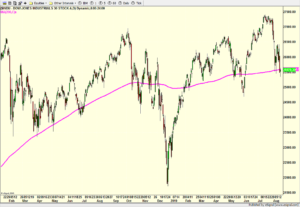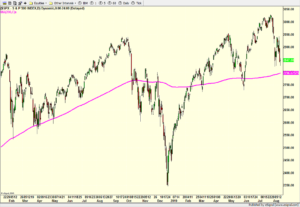Bear Clowns Wrong, AGAIN – Dow 28,000 on the Way
The news backdrop certainly isn’t good. Trump adds tariffs. China threatens retaliation. Hong Kong protests. China readying to “invade”. Germany and Italy in recession. Yield curve inverts in U.S. Recession fears explode higher. All of this sounds so bad. Like there is no hope, just darkness.
Yet stocks are merely 6.5% from an all-time high. 6.5%!
I will go one step further. News like I mentioned more often occurs as the stock market gropes for a bottom than puts in a meaningful peak. News like this creates fear, not greed and fear is the emotion that happens during market lows, not near highs.
The S&P 500 has pulled back 6% on a closing basis since its last all-time high on July 26, just like it has done more than 30 times since 1950 (5-9.9% pullback). Yet, the vast majority of what I am watching, hearing and reading is making people feel a whole lot worse and believe that stocks are down more than 10%. As usual, the data do not support the conclusions of the masses.
Additionally, short, sharp declines from all-time highs are not how bear markets usually begin and that’s not what we saw in 2007 and 2000. Short, sharp declines from all-time highs are typically recovered from in less than two months.
With all that said, as I type this, I do not believe the final low is in just yet for stocks. However, as I said on multiple TV programs this and last week, I didn’t think it paid to be too cute here. In this case I wanted to be positioned a little early than a little late. Most or much of the price damage has already been seen, but the decline does not look perfectly complete right now. While that could change very quickly, Dow 25,000 or even 24,500 wouldn’t not be a shock as I have written about for the past few weeks.
Lots and lots of people watch the average price of the last 200 days as a gauge of the market’s overall trend. Some say it’s a self-fulfilling prophesy when price gets close as humans and the computers push it to the finish line. Below you can see the Dow and S&P 500 with the pink line representing the 200 day moving average.
Over the past 19 months we have seen a number of times, especially on the left side of each chart where price came down to kiss the pink line and then rally. However, we also saw last fall where that long-term gauge of trend did not hold. On the right side of each chart, you can see the Dow saying hello to the pink line right now, while the S&P 500 remains a bit above it.
The bottom line is that in the strongest markets, price normally holds at or around the pink line. Conversely, in the weakest markets, rallies are capped at or near the pink line on the way back up.


When looking for opportunities today, a barbell approach, usually reserved for bonds, is one that makes sense to me. By barbell, I am looking for some less volatile sectors on the left side and some more volatile sectors on the right side. Staples, REITs and utilities would fill the left while semiconductors would fill the right. Right now, I am not all that interested in things like industrials, materials, energy (although it should see a big bounce soon), biotech, retail and banks (although diversified financials look much better).
Finally, and the answer to the question everyone keeps asking over and over again, the bull market remains intact and will need to see at least another fresh, all-time high before the possibility of a bear market enters my thinking. There are too many positives and not enough serious warning signs in the financial markets to build the foundation for a bear market, no matter how many people are hoping and praying for one for some moronic reason.
The bear clowns are alive and well in the media and on Twitter, still beating their chests for the 10th straight year. Their wildly negative, gloom and doom forecasts sell well during interviews and scare the masses, but have done nothing to help investors make money. This bull market remains the most hated and disavowed in history and until the retail public returns to invest, stocks will move higher on balance.

